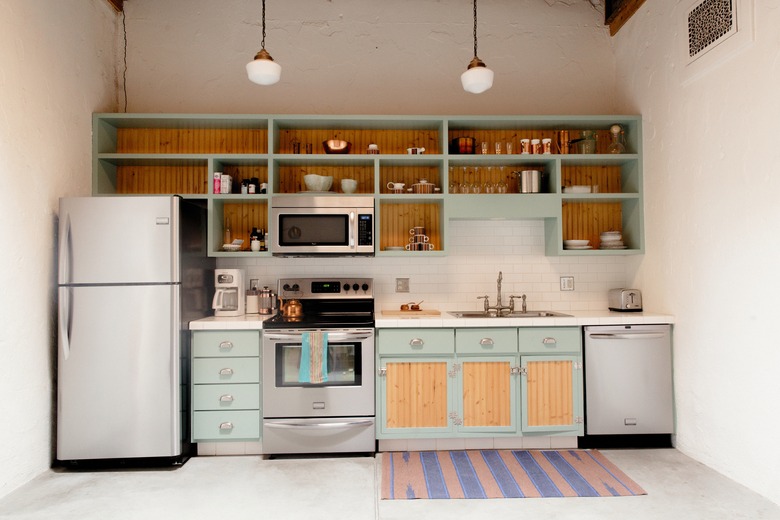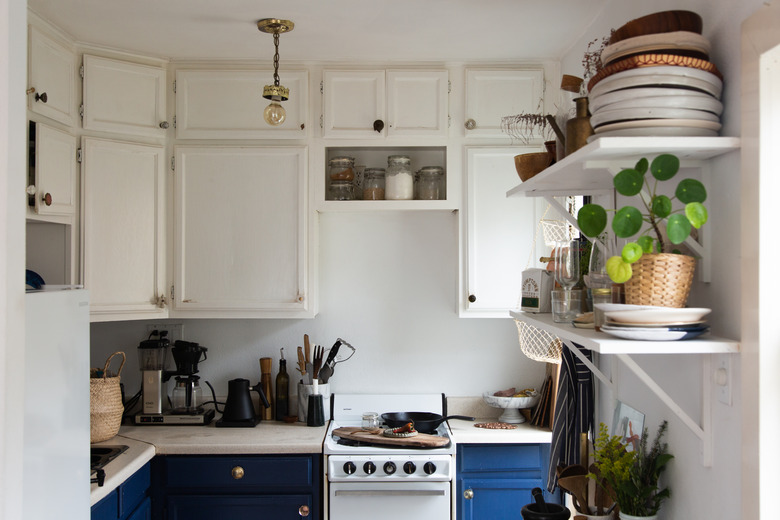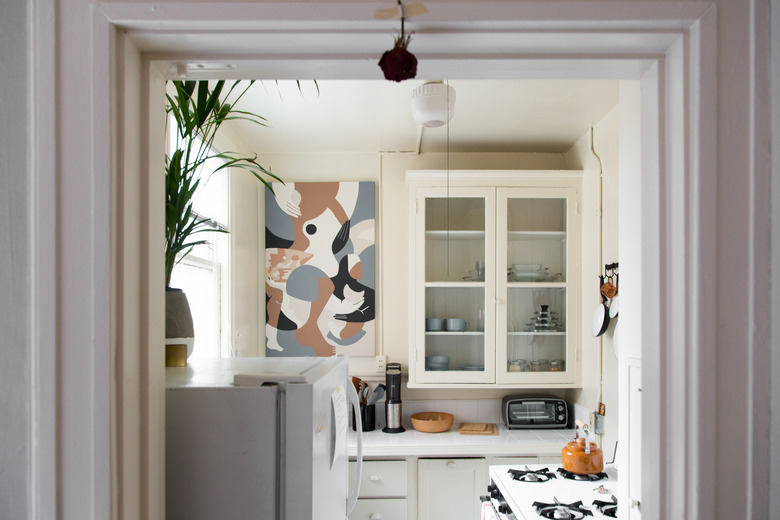How To Choose Kitchen Accent Lighting
When remodeling your kitchen, it's easy to get so focused on countertops and cabinets that lighting the space becomes an afterthought. Lighting, however, can have a huge impact on the look, feel and functionality of the space — especially kitchen accent lighting, which adds subtle but important details to the room.
The right kitchen accent lighting for you depends on the look you're seeking and how you use your kitchen. Choose your accent lighting based on what parts of your kitchen you want to highlight and what type of look and feel you're seeking. Each type of accent light serves a different purpose, and you can mix and match them in whatever way works for your kitchen design and layout.
General, Task and Accent Lighting
General, Task and Accent Lighting
When illuminating your kitchen, there are three types of lighting about which you need to know. The first is ambient lighting. Ambient lighting serves as the base lighting for the room and is the general lighting that illuminates the overall kitchen space. According to Lumens, ambient lighting illuminates any space in the kitchen where you might step. This type of light is usually provided by overhead flush mount or recessed lighting fixtures.
You'll also need some task lighting in your kitchen. Task lighting focuses on a specific workspace so you can easily see what you're doing. You may, for instance, want some extra light on your countertop when cutting vegetables or over the sink when doing the dishes.
Lastly, you'll want to add accent lighting to the space. Accent lighting highlights features of your kitchen that you want to show off, such as artwork or china pieces. Accent lighting also tends to be more muted than other lights, allowing you to create some ambiance and to create a more intimate feel when desired. Many homeowners ask their electrician to wire their accent lighting separately so they can easily turn on just the accent lights independent of the other lighting. There are six types of accent lighting from which you can choose depending on your style and how you use your kitchen.
Undercabinet Lighting
Undercabinet Lighting
As the name implies, undercabinet lights are installed on the underside of your kitchen cabinets and shine light down onto your countertops. Available as both pucks and light bars, homeowners often use a dimmer switch along with undercabinet lights. This allows the lights to double as task lighting when needed. Simply turn the lights up when you're working and turn them down to create a little atmosphere or to serve as night lights.
When used as accent lights, undercabinet fixtures are an excellent way to show off beautiful countertops and backsplashes. Unfortunately, they'll also show off cluttered counters, so think carefully about how you really use your kitchen.
Undercabinet lights typically screw into the bottom of your cabinet and then get hardwired to a light switch. To avoid running wires inside your walls or cabinets, you can opt for battery-powered lights instead. These can chew through batteries in a hurry, however, so use them only as a last resort. You can also avoid screw holes in your cabinets by using lights with an adhesive backing, but these generally don't perform well.
Above-Cabinet Lighting
Above-Cabinet Lighting
If you want to add drama to your space without a fancy chandelier, consider above-cabinet lighting. This type of kitchen accent lighting sits on top of your cabinets and shines up at the ceiling, highlighting any fancy crown molding or wallpaper borders. You can also use it to highlight houseplants or collectibles you set on top of your cabinets. Be forewarned, however, that these fixtures literally shine a light on your ceiling and will show any cracks or imperfections. Give the ceiling a fresh coat of paint before installing above-cabinet lights.
Light strips and rope lights are the best way to add above-cabinet lighting to your space. These lights are easy to replace should the need arise and often come with a dimmer. If you want above-cabinet lighting, ask your electrician to install an electrical outlet on top of your cabinets so you can easily plug in your rope lights. You can plug rope lights into each other to make them longer or wind them around themselves to make them shorter so they fit your space perfectly.
Kitchen Cabinet Interior Lighting
Kitchen Cabinet Interior Lighting
If you like to shove clutter in the kitchen cabinets to hide it, interior cabinet lighting is not the right kitchen accent lighting choice for you. If, however, you have a collection of fine china, crystal glassware or other kitchen accessories you would like to show off, cabinet lighting is perfect. To do more with less light, replace the cabinet shelves with glass ones.
Although they can be wired to a light switch in the kitchen, most lighted cabinets have a switch tucked discreetly inside them. You can often buy glass-front cabinets with accent lights already built into them and simply wire them into your existing electrical. If your cabinets don't have lights, you can add thin light strips under each cabinet shelf or install mini spotlights on the bottom of the cabinet shining up. Lightology also recommends mounting one light bar at a 45-degree angle on the top back corner of the cabinet.
Toe-Kick Lighting
Toe-Kick Lighting
Toe-kick lighting is the opposite of above-cabinet lighting. Instead of sitting on top of your cabinetry and shining at the ceiling, toe-kick lights hang under your cabinets from screwed-in clips and shine light on the floor. These accent lights make great night lights and add drama to the space, making it look almost as if your kitchen cabinets or island are floating. You can also use them to create a walkway or help set the kitchen apart from the living space if you have an open floor plan.
Light strips and ropes make excellent toe-kick lights that can be hardwired to the same switch as your other kitchen accent lighting. Tread carefully, though, as LED lights are tricky if you have very shiny floors. On shiny floors, it's often possible to see each individual LED in the light rope reflected in the floor, taking away from the effect of toe-kick lighting. If your floors have a glossy sheen, mount your LED rope light on its side or buy one that diffuses the light through a translucent cover.
Track Lighting in the Kitchen
Track Lighting in the Kitchen
Track lighting is an excellent accent lighting choice when you want to highlight several areas of your kitchen at once. When installing track lighting, you'll fasten a metal track to the kitchen ceiling and place several individual lights along the track. These lights adjust independently of each other, allowing you to point each one in a different direction.
This allows you to point one light at a favorite piece of artwork, another at your kitchen island and another at a favorite vase that you set on top of your kitchen cabinets. You can also use track lighting to accent high-end appliances like a wine refrigerator or double oven. If you move some of your favorite kitchen decor pieces, you can simply adjust your track lighting to keep the focus where you want it.
Kitchen Island Lighting
Kitchen Island Lighting
Kitchen islands often pull double duty, functioning as a workspace and a focal point in the kitchen. As such, the accent lighting that helps draw your eye to the island also frequently doubles as task lighting. If you want your accent lighting to do so, hang pendant lights above the island. If you want to highlight the island itself but don't need any additional overhead light, consider installing toe-kick lights around the bottom of the island instead.
You can also choose to use track lighting to highlight your kitchen island, but make sure you do it right. If the track light is behind you when you stand at the island, you'll constantly be in your own shadow when working there. Hang the light in front of your workspace and you may find it shining in your eyes. Consider pointing two track lights at the island instead, with one shining in from each side.


